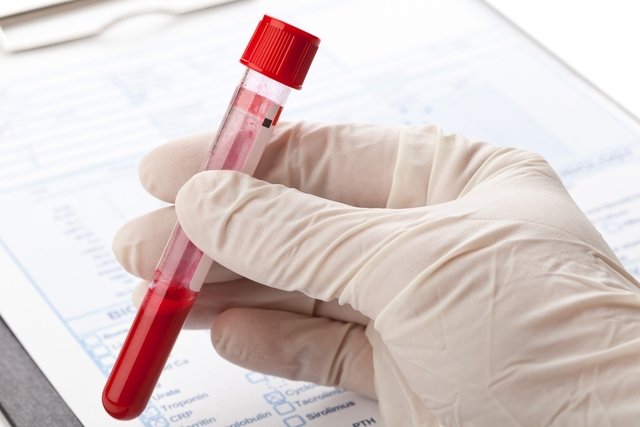CA 125 is a protein naturally produced in the ovaries, serosa, fallopian tubes and intestine, and may be increased in the blood due to pregnancy, menstrual periods, endometriosis and, sometimes, in cases of cancer, especially ovarian cancer.
Normally, the dosage of CA 125 is indicated when ovarian cancer is suspected, to monitor the response of this type of cancer to treatment and also identify the return of the tumor after surgery.
It is important to emphasize that this exam should not be carried out without precise medical advice. In case of high CA 125, it is important to consult a clinician or gynecologist, so that other tests can be carried out to identify the cause of the change, such as ultrasound, magnetic resonance imaging and biopsy to confirm the diagnosis.

What is it for
The dosage of CA 125 is used for:
- Non-diagnostic assistant ovarian cancer;
- Monitor response to chemotherapy in case of ovarian cancer;
- Confirm that ovarian cancer has been completely removed after surgery;
- Identify if ovarian cancer has returned after treatment with surgery.
Furthermore, the dosage of CA 125 may also be indicated to monitor the evolution of some serosal tumors.
CA 125 Exam
The CA 125 test is carried out by analyzing a blood sample collected in the laboratory. The CA 125 test is normally recommended by your doctor if you suspect ovarian cancer or to monitor your treatment. Find out about other tests that detect cancer.
Generally, fasting is not necessary to perform the test and the result can be released after 1 day depending on the laboratory in which it is carried out.
CA 125 reference value
The CA 125 reference value considered normal is up to 35 U/mL. However, the reference value may vary slightly according to the laboratory and detection method performed, and it is important to pay attention to the reference value present in the report.
CA 125 high
CA 125 is considered high when a concentration of this protein greater than 35 U/mL is identified, which may happen due to:
In addition, other types of tumors, such as breast, endometrial, lung and pancreas cancer, can also cause high CA 125, and it is important to carry out other tests, such as MRI and biopsy to confirm the diagnosis.
When is CA 125 considered cancer?
There is no specific value of CA 125 that is considered an indicator of cancer. However, the risk is greater when it is above 35 U/mL, especially in women who were already suspected of having ovarian CA and have other indicative tests.
The CA 125 measurement alone does not confirm the diagnosis of ovarian cancer, requiring other tests, such as transvaginal ultrasound and magnetic resonance imaging. See the tests that can be requested for ovarian cancer.
Bibliography
- DOCHEZ, Vincent et al. Biomarkers and algorithms for diagnosis of ovarian cancer: CA125, HE4, RMI and ROMA, a review. J Ovarian Res. Vol.12, n.1. 28, 2019
- BIGGS, Wendy S; MARKS, Sarah T. Diagnosis and Management of Adnexal Masses. Am Fam Physician. Vol.93, n.8. 676-681, 2016
- U.S. PREVENTIVE SERVICES TASK FORCE. Ovarian Cancer: Screening. Disponível em: <https://www.uspreventiveservicestaskforce.org/uspstf/document/RecommendationStatementFinal/ovarian-cancer-screening>. Acesso em 09 jan 2023
- STATPEARLS. Ovarian Cancer. 2022. Available at: <https://www.ncbi.nlm.nih.gov/books/NBK567760/>. Accessed on January 9, 2023
- STATPEARLS. Cancer Antigen 125. 2022. Available at: <https://www.ncbi.nlm.nih.gov/books/NBK562245/>. Accessed on January 9, 2023
- BONIFACIIO, Vasco DB Ovarian Cancer Biomarkers: Moving Forward in Early Detection. Adv Exp Med Biol. Vol.1219. 355-363, 2020
- LEE, SW; et al. Predictive Markers of Tubo-Ovarian Abscess in Pelvic Inflammatory Disease. Gynecol Obstet Invest. Apr 23. 2015
- EDULA, RG; et al. CA-125 Significance in Cirrhosis and Correlation with Disease Severity and Portal Hypertension: A Retrospective Study. J Clin Transl Hepatol. 6. 3; 241-246, 2018
- ABDUL, KAK; et al. The Effect of Surgical Intervention of Endometriosis to CA-125 and Pain. Malays J Med Sci. 27. 6; 7-14, 2020
- ZHANG, M.; et al. Roles of CA125 in diagnosis, prediction, and oncogenesis of ovarian cancer. Biochim Biophys Acta Rev Cancer. 1875. 2; 188503, 2021
- KWON, J. S. Preoperative CA-125 in low-grade endometrial cancer: risk stratification and implications for treatment. Gynecol Oncol. 30. 5; e92, 2019
- DOCHEZ, V.; et al. Biomarkers and algorithms for diagnosis of ovarian cancer: CA125, HE4, RMI and ROMA, a review. J Ovarian Res. 12. 1; 28, 2019
- BONIFÁCIO, VDB Ovarian Cancer Biomarkers: Moving Forward in Early Detection. Adv Exp Med Biol. 1219. 355-363, 2020
- GANDHI, T.; BHATT, H. IN: STATPEARLS (INTERNET). TREASURE ISLAND (FL): STATPEARLS PUBLISHING. Cancer Antigen 125. 2021. Available at: <https://www.ncbi.nlm.nih.gov/books/NBK562245/>. Accessed on Jul 12, 2022

Sign up for our newsletter and stay up to date with exclusive news
that can transform your routine!
Warning: Undefined array key "title" in /home/storelat/public_html/wp-content/plugins/link-whisper-premium/templates/frontend/related-posts.php on line 12
Warning: Undefined array key "title_tag" in /home/storelat/public_html/wp-content/plugins/link-whisper-premium/templates/frontend/related-posts.php on line 13




